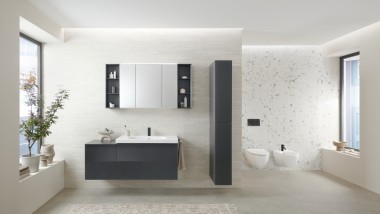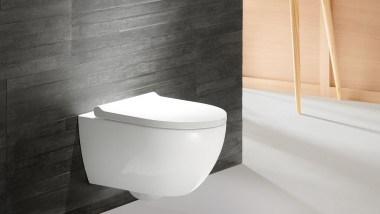Bathroom colours Tips for a balanced colour scheme
Choosing a colour in the bathroom is a tough one for many. The range of different colours on offer is huge. Furthermore, technical aspects such as high levels of moisture and cleaning have to be considered. These ideas should help you choose the right colour for your bathroom.
IS SPECIAL PAINT NEEDED IN THE BATHROOM?

It is recommended to use special paints in the bathroom that prevent mould growth. Because of the water vapour, the room climate in the bathroom is very humid.
Conventional emulsion paints are usually not compatible with the high level of moisture seen in the bathroom. Suitable paints are labelled accordingly. Silicate paint or latex paint are both ideal.
Silicate paint has many advantages. It is breathable and can absorb and then emit moisture in the air. This improves the indoor climate. Furthermore, silicate paints are also suitable for allergy sufferers, as they are usually free of solvents. Lastly, silicate paints are mainly alkaline, which ensures that mould has no place to grow.
Latex paint is made of resin (nowadays mainly synthetic resin). It is moisture-resistant, robust and easy to clean. However, please note that latex paint cannot be painted over, because the new wall paint does not adhere to the substrate. In addition, the removal is very time-consuming – latex paint must be sanded off or leached. If you live in a rented apartment, it is best to discuss the painting in the bathroom with your landlord.
what should you watch out for when buying paint for the bathroom?
As in all home improvement projects, the work should be carried out professionally. Get advice from your local DIY shop or leave the work to a professional.
In addition to choosing silicate or latex paint, cleaning is also an important point. In the shower area in particular, acidic cleaning agents are used for removing limescale. These can damage the wall paint. In this context, paint manufacturers classify and label their products in five wet abrasion classes:
- Class 1: Most durable and robust, can be cleaned with normal cleaning agents, sponges or flowing water
- Class 2: Robust, can also be cleaned with an abrasive sponge or brush
- Class 3: Conditionally abrasion-resistant, can be cleaned with cleaning agents, sponge or muscle power
- Class 4: Sensitive, but can be cleaned with a damp, soft cloth
- Class 5: Least robust, can be damaged with even a soft cloth
Bathroom colours – step by step to the right colour concept
Choosing the right colour for your bathroom is a key step in the design process. But before you get out the colour charts, you should first consider whether to use tiles.
Laying the foundations – tiles or no tiles
If you choose tiles in the bathroom, then both the tile colour and size are important aspects. The “grouting-free” look has become increasingly popular for some very good reasons:
- 1. Design: Grouting can disrupt the look of a room. Larger tile formats create a calmer, more harmonious atmosphere in the room.
- 2. Hygiene: Grouting has a tendency to accumulate dirt – and dirt is often wiped into the grouting during cleaning. Additional, time-consuming cleaning is then required to bring the bathroom back up to scratch. If not cleaned properly, mould can even build up in grouting.

The rear shower wall is a special case as it is exposed to a lot of moisture. If you don’t want to use tiles, here are two alternatives:
- “Elephant skin” protection: The wall is sealed with a special transparent resin that makes conventional paints or wallpaper waterproof. Please note that the surface will have a gloss finish after application.
- Latex paint: This paint is moisture-resistant and requires a waterproof plaster render. While latex paint is resistant to water vapour, it is not 100% waterproof. Please note that imperfections should not be painted over as this can lead to water damage or mould formation.
Choosing Feel-good colours for the wall
Colour tones have an influence on how big we perceive a room to be. Therefore, when choosing the wall colour, it is also important to pay attention to the size of the room. Bright and bold colors tend to make a room smaller, while pastel tones make a room appear larger.
Pastel tones are inviting and give a feeling of space

Colours such as beige, light grey or powder shades are often seen on bathroom walls. Neutral wall colours have a modern appearance and impress thanks to their timeless beauty. Moreover, they also give white bathroom furniture, washbasins and toilets a particularly elegant look.
- Sand shades generally give a warm feeling. Sand and nude shades harmonise body and soul and create a visible sense of peace and calm.
- A wide variety of grey tones are available. By adding a little brown, a warm grey is created. In contrast, the grey appears cool when a little blue is added.
- Pastel colours like light blue, rose pink or mint ensure a sense of lightness and well-being in the room. When combined with white, pastel colours make a friendly impression whilst also making small bathrooms appear larger.
Our tip: No matter what you choose, always test a colour directly in the bathroom before painting the wall with it. Either with a sample coat of several colours next to each other directly on the wall or with a test sample on wood or cardboard. View the result at different times of the day. This is because the incidence of light and the environment (for example, the colour of the tiles, bathroom furniture or ceiling) can significantly influence the perception of colour.


Setting accents with colourful bathroom fittings
Of course, it doesn't always have to be white when it comes to bathroom ceramics and furniture. In the meantime, there are also coloured washbasins and toilets on the market. If that's too colourful for you, matt ceramics could be an attractive alternative. In particular, products in matt white or matt black are discreet and still stand out from the standard.
For more color in the bathroom, it is not absolutely necessary to paint walls or replace products. Interior designers set accents with colourful bathroom accessories. The advantage over wall painting is that bathroom utensils can be replaced easily and cost-effectively. The following are suitable splashes of colour:
- Textiles such as towels, bath mats, carpets or shower curtains
- Soap dispensers, toothbrush glasses and towel rails
- Vases and plant pots
- Pictures and sculptures
- Decorative items such as lights, candles and candlesticks
- Small pieces of bathroom furniture
- Tailored actuator plates
Plants can also bring colour to the bathroom together with a natural ambience. But watch out, not every plant is suitable for bathrooms.
FAQ on planning colours in the bathroom
Are there any emerging trends for materials and colours in the bathroom?
Black bathroom furniture and accessories are currently in vogue. When used sparingly and combined cleverly, black products make a powerful statement. Renowned architects are now increasingly using black in the bathroom.
Wood in the bathroom remains a popular choice. It has a connection to nature like no other material and ensures a feel-good atmosphere in the bathroom thanks to its look, feel and smell.
Combining different materials is also popular. Exciting effects can be created in this way. The advantage: If different materials are combined with one another, the result is an individual style that is pleasing both to the eye and to the touch.
















